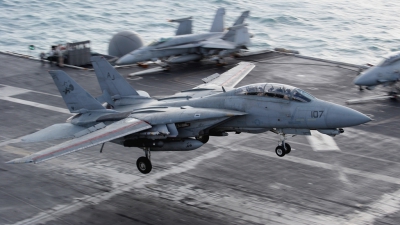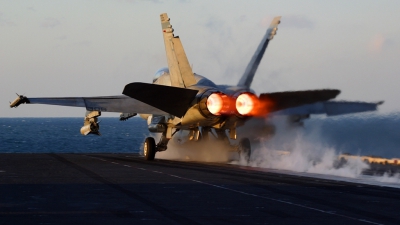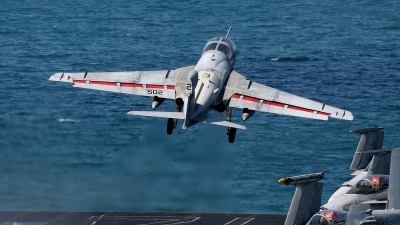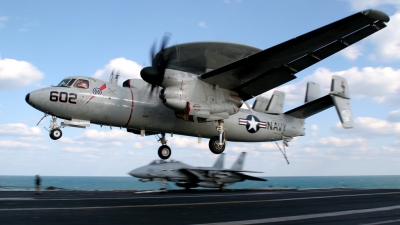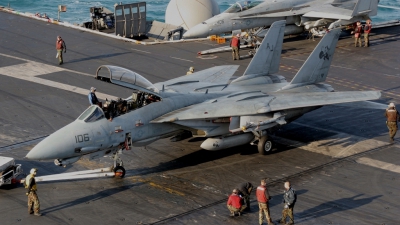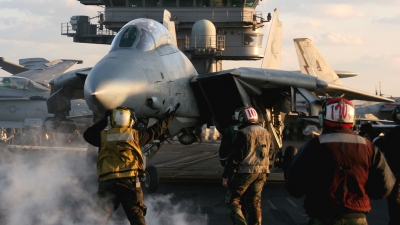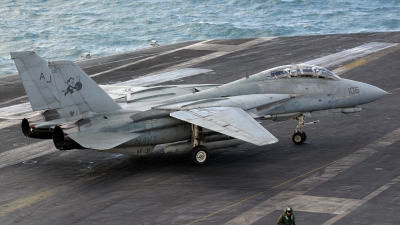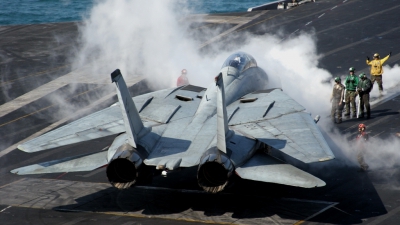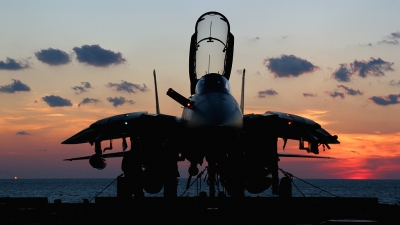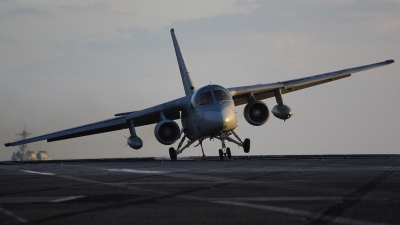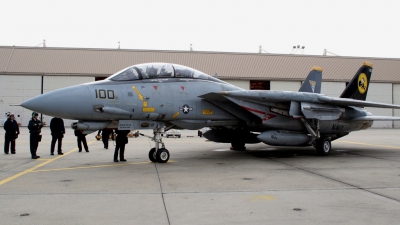
The US Navy Aircraft Carrier USS Theodore Roosevelt (TR) returned from its 2005/6 Med/Gulf Deployment on Saturday March 11th 2006, marking the end of US Navy Carrier Operations of the venerable Grumman F-14 Tomcat.
Known as America’s “Big Stick” USS Theodore Roosevelt (CVN-71) is the fourth Nimitz-class aircraft carrier for the Navy. Placed in active service on October 25th 1986, CVN-71 then started her maiden deployment on December 30th 1988 with CVW-8 embarked. Roosevelt returned from her eighth deployment on May 29th 2003 having seen combat in as many as six deployments, including the first Gulf War in January 1991 and subsequent Operation Southern Watch, Operation Deny Flight over Bosnia, Operation Allied Force over Kosovo, and latterly Operation Enduring Freedom and Operation Iraqi Freedom following the events of September 11th 2001. On its 17th Birthday in October 2003 CVN-71 had been to war more than any other Nimitz-class carrier and had won no end of awards and honours during its time in the Navy. All of her deployments were made with CVW-8 except for brief spells with CVW-3 for the fifth deployment (1996/97) and CVW-1 for the seventh deployment (2001/02). And so it was that on its ninth deployment, again with CVW-8 onboard, Roosevelt had the honour of being the last carrier to host the F-14 Tomcat, just something else to add to the ships impressive history.
Having left its home port of Norfolk, Virginia on September 1st 2005, TR along with its embarked Carrier Air Wing of CVW-8 then made their way across the Atlantic bound for the Persian Gulf and the 5th Fleet area of responsibility, where it would be stationed for the next 4 months in support of “Operation Iraqi Freedom” (OIF) and the Global War on Terrorism. Having made Port Calls at Palma de Mallorca (Sept 13-17th) and Naples (Sept 19-23rd), Roosevelt then transited the Suez Canal on Sept 27th and eventually arrived in the Gulf in early October 2005 to relieve the USS Nimitz, which had come to the end of its deployment.
Roosevelt launched her first aircraft of this deployment in support of Operation Iraqi Freedom on October 6th when CVW-8 launched their first combat operations for more than two and a half years. CVW-8 was made up of six different aircraft types belonging to eight Squadrons. VF-31 “Tomcatters” and VF-213 “Black Lions” operating the F-14D Tomcat, VFA-15 “Valions” and VFA-87 “Golden Warriors” operating the F/A-18C Hornet, VAQ-141 “Shadowhawks” operating the EA-6B Prowler, VAW-124 “Bear Aces” operating the E-2C Hawkeye, VS-24 “Scouts” operating the S-3B Viking and HS-3 “Tridents” operating the SH-60/HH-60 Seahawk. Additionally two C-2A Greyhound aircraft operated by VRC-40 “Rawhides” provided COD (Carrier onboard delivery) providing an essential link to the mainland for the purpose of carrying mail and personnel to and from the ship as well as any essential supplies. For this particular cruise though, it was the Tomcats that were conjuring up the majority of the interest.
Widely regarded as the best Tomcats taken on cruise for a number of years, 22 F-14D's were assembled onboard Theodore Roosevelt evenly split between VF-31 and VF-213. Known as the ultimate Tomcat, the ‘D’ model was a big improvement on the original F-14A largely due to the use of the General Electric F-110 engine and the awakening of its attack role. Also used in the F-14B, the F110-GE-400 engines provided far greater thrust, which improved fuel consumption by nearly 30%. The extra thrust provided by these engines meant that no afterburner was required for carrier launch, something which crucially helped hide the presence of an aircraft carrier at night, as an afterburner can be seen over 30 miles away. Other improvements included a new radar system, a digital avionics suite and LANTIRN (Low Altitude Navigation and Targeting Infra Red for Night) targeting pod, which meant that the aircraft went from being a Long Range Interceptor/Air Superiority Fighter to a Multi-role Strike Fighter, something that had been envisaged in the original design and which in turn led to the nickname "Bombcat".
For the “Black Lions” of VF-213 the work up for this cruise had been quite a slow one. Having last deployed aboard TR in early 2003, VF-213 returned to their home base of NAS Oceana in Virginia at the end of May 2003, where apart from work-up deployments, they would remain until September 2005 and the start of their final cruise. Having long been associated with the Pacific Fleet, the 2003 Roosevelt Cruise was the Black Lions first with an Atlantic Fleet Air Wing since being switched from the Pacific Wing of CVW-11 to make way for Super Hornets.
In stark contrast the “Tomcatters” of VF-31 had a rather more hectic time in the run up to the final cruise. VF-31 had also spent a number of years with the Pacific Fleet as part of CVW-14 where they had the honour of being the last Tomcat Squadron to cruise with the Pacific Fleet between May and November 2004 aboard USS John C. Stennis. Having arrived back at NAS Oceana in early November 2004 they were almost immediately tasked with working up for the 2005 Roosevelt cruise where they would team up with VF-213, their old Miramar stable mates.
The primary missions flown by the Tomcats on this deployment were Close Air Support and Reconnaissance in support troops on the ground in Iraq as well as Maritime Security Operations around the Persian Gulf. A number of air to ground weapons were available to the Squadrons, including the 500lb JDAM, which was cleared for use on the Tomcats just weeks before they departed for the Gulf. Although the majority of missions flown resulted in the aircraft returning to the ship with their weapons still intact, there were times when 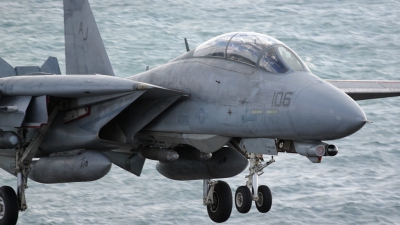 they had been heavily involved in releasing their ordnance. On October 19th Tomcats attacked an Improvised Explosive Device production facility Northeast of Baghdad. In mid November the Tomcats were again in action, this time in support of Operation Steel Curtain (OSC) where strikes against terrorist targets were carried out over 5 days supporting Coalition troops on the ground. On December 10th further improvements were made to the Tomcats onboard TR with the addition of ROVER (Remotely Operated Video Enhanced Receiver). For the small sum of approximately 800 dollars per aircraft, the new system allowed forward ground controllers to see real time exactly what the crew could see by transmitting from the aircrafts sensors direct to the controllers laptop, meaning that the controller could identify targets visually rather than relying on audible directions from the Pilot. On December 11th aircraft 161166 AJ-207 of VF-213 became the first Tomcat to use the system in combat, with the entire fleet being capable within a few days. Lt. Nicholas “Thumbs” Smith, a Radar Intercepts Officer (RIO) with VF-31 said, “Since being fitted with ROVER requests have come from all over the region for Tomcats to be on station simply because they have the (ROVER) capability and carry JDAM’s”. Typically the Tomcat Crews were flying missions every other day and although the maintenance crews were kept busy the aircraft performed brilliantly throughout the cruise. Some of the more experienced crew members stated that they had flown more often on this cruise than any other that they had been a part of.
they had been heavily involved in releasing their ordnance. On October 19th Tomcats attacked an Improvised Explosive Device production facility Northeast of Baghdad. In mid November the Tomcats were again in action, this time in support of Operation Steel Curtain (OSC) where strikes against terrorist targets were carried out over 5 days supporting Coalition troops on the ground. On December 10th further improvements were made to the Tomcats onboard TR with the addition of ROVER (Remotely Operated Video Enhanced Receiver). For the small sum of approximately 800 dollars per aircraft, the new system allowed forward ground controllers to see real time exactly what the crew could see by transmitting from the aircrafts sensors direct to the controllers laptop, meaning that the controller could identify targets visually rather than relying on audible directions from the Pilot. On December 11th aircraft 161166 AJ-207 of VF-213 became the first Tomcat to use the system in combat, with the entire fleet being capable within a few days. Lt. Nicholas “Thumbs” Smith, a Radar Intercepts Officer (RIO) with VF-31 said, “Since being fitted with ROVER requests have come from all over the region for Tomcats to be on station simply because they have the (ROVER) capability and carry JDAM’s”. Typically the Tomcat Crews were flying missions every other day and although the maintenance crews were kept busy the aircraft performed brilliantly throughout the cruise. Some of the more experienced crew members stated that they had flown more often on this cruise than any other that they had been a part of.
Although there was a lot of sadness surrounding the end of the F-14 within the Tomcat community, morale was still high and most of the crews due to transition to the Super Hornet were looking forward to their new challenge. Nugget Pilot Lt. Gerrit Everson on his first cruise with VF-213 said, “I feel fortunate to fly the Tomcat. It was my first choice and I was thrilled to be told that I would be going onto the F-14 after my initial (flight) training. It’s pretty neat to be part of the last cruise, but at the same time I am looking forward to transitioning to the Super Hornet”. Lt. Nicholas Smith added, “It’s kinda cool being part of the last cruise, but things are always changing in the Navy, people move on and technology improves”.
On February 8th 2006 history was made when, at 00.35, the Commander of CVW-8, Capt. William G. Sizemore II, trapped aircraft AJ-204 of VF-213, marking the last recovery of an F-14 Tomcat from a combat mission. This followed the last bomb drop from a Tomcat when Lt. Bill Frank of VF-31 released a weapon on the same mission. This brought about a total of 1,163 combat sorties flown by VF-31 and VF-213 during the four month Gulf deployment, totalling 6,876 flight hours, with the squadrons dropping 9,500 pounds of ordnance.
On return to Virginia, VF-213 immediately started to relinquish their Tomcats as they began the transition to the Super Hornet and become VFA-213. VF-31 however had a little longer to reflect on the final cruise as they became the very last F-14 Squadron in the Navy and began to transition to the F/A-18E in September 2006, becoming VFA-31. After the Tomcat farewell in late September 2006, the familiar whistle of an F-14 on approach to NAS Oceana became all but a memory by the beginning of October, bringing to an end the impressive history of an aircraft that became a household name after starring in a certain 1986 movie.
With the Tomcats hogging the limelight on their final cruise, it was a lesser known fact that VS-24 “Scouts” were also on their final cruise with their S-3B Vikings, which are scheduled to decommission in 2007. First flown in 1974, the Vikings primary role of Anti-submarine warfare (ASW) has long since been handed over to land based P-3 Orion’s and sea based SH-60 Seahawk helicopters, which has led to the S-3’s adopting a main role as a carrier based in-flight-refuelling aircraft using the “Buddy-Buddy” refuelling system. However, the Vikings also have a surface attack capability using the AGM-84 “Harpoon” and AGM-65 “Maverick” missiles as well as the capability to control the AGM-84 “SLAM/ER” (Stand off Land Attack/Extended Range) missile when launched from another platform. Other roles include, Over-the Horizon Targeting, Amphibious Warfare, Airborne Reconnaissance, Command and Control, as well as surveillance, electronic warfare and search and rescue. The S-3B like the Tomcat is also being phased out in favour of the Super Hornet, which incorporates the flight-refuelling role as part of its multi-role characteristics. Scheduled for retirement in 2009, the Viking will be phased out over the coming years as the Super Hornets are gradually added to the fleet. As an air wing receives one Super Hornet Squadron then the wings S-3 Squadron will reduce from 8 to 6 aircraft and as the wing receives its second Super Hornet Squadron, then the S-3 Squadron will be withdrawn from the wing. So as an air wing full of Super Hornets nears ever closer, the Viking will become yet another aircraft that will be sadly missed from the decks of US Navy aircraft carriers of the future.
Another noteworthy event on this cruise was that of VAQ-141 “Shadowhawks” becoming the first Navy “Prowler” Squadron to set up a land base in Iraq with their EA-6B’s. With USS Nimitz departing from the Persian Gulf prior to Roosevelt’s arrival, air support was reduced due to having no carrier air wing to call upon. Therefore on September 17th while still in the Mediterranean Sea, two Prowlers departed USS Theodore Roosevelt bound for the Al Asad air base in Iraq, the primary objective being to assist Marine Electronic Attack Squadron (VMAQ) 1 in supporting coalition ground forces in Iraq. After 37 combat missions the 2 aircraft and 62 personnel returned to Roosevelt on October 6th when flight operations started on TR in the Gulf, but shortly afterwards the decision was taken to send a detachment to the Iraqi base indefinitely, something which was ongoing during the authors visit to TR on January 18/19th, as only one Prowler was in residence for training purposes.
Towards the end of November five of CVW-8’s F/A-18C's also paid a visit to Al Asad while Roosevelt made a scheduled port call to Jebel Ali in the United Arab Emirates. Around 50 personnel from VFA-15 and VFA-87 made the journey to Iraq in order to maintain a strike capability whilst TR was conducting the port visit.
So as the USS Theodore Roosevelt returned home to Virginia and with it the end of an era, a sign of the times came with its successor in the Persian Gulf. The Navy’s newest Nimitz class aircraft carrier, USS Ronald Reagan (CVN-76), set sail from its homeport of San Diego on January 4th 2006 on its maiden six-month deployment, to relieve the TR and continue providing security and air cover for OIF. Onboard, her air wing of CVW-14 consisted of fixed wing aircraft made up of two Squadrons of F/A-18E Super Hornets, two Squadrons of F/A-18C Hornets, a Squadron of EA-6B Prowlers and a Squadron of E-2C Hawkeye’s!
The author would like to thank all Public Affairs staff of the US Navy 5th Fleet in Bahrain and onboard CVN-71 for their help and assistance in making this article possible.
